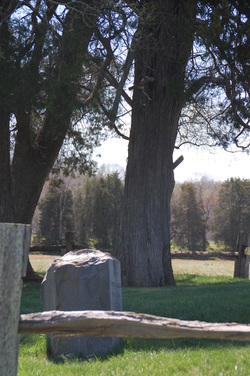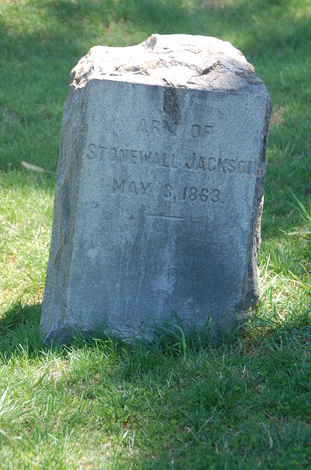 Today is May 3rd, and I can’t let the day pass without mentioning one of my very favorite places to visit-- a listing limestone marker in a family plot on a quiet corner of the Wilderness Battlefield. Here lies Stonewall Jackson. Well a part of him. Probably. On May 2, 1863, General Thomas “Stonewall” Jackson led an audacious 12 mile march to surprise the Union troops on the Army of the Potomac’s right flank. The attack crumbled the Union line and blue troops ran in a disorganized retreat several miles before finally stopping and reforming nearer the crossroads lodging house known as Chancellorsville. Stonewall was famous for his aggression, and the night of May 2nd was no exception. To follow up his rout of the Union right flank, he considered a night attack. First, however, he needed to reconnoiter the enemy position. This he did, without bothering to tell his troops of his intentions. While Jackson, General Ambrose Powell Hill and members of Jackson’s staff moved forward, a brigade of North Carolinians moved in behind the party. Suddenly, without his knowledge, Jackson was caught in No Man’s Land. On his way back to his lines, the North Carolinians, waiting in the gloom of the Wilderness, near enough to the enemy to hear them digging, the darkness close around them, mistook the approaching mounted party as Union cavalry. Though Jackson’s party told the Confederate soldiers they were friends, the North Carolinians didn’t believe them and opened fire. Jackson was hit three times--once in his right hand, twice in his left arm. The Union troops responded to the Confederate volley with canister fire from the cannons positioned on the nearby roads. Jackson was dropped several times while his comrades attempted to evacuate him under heavy antipersonnel artillery fire. Jackson was taken to a field hospital near Wilderness Tavern where his arm was amputated. Amputation was quick and common in the Civil War as the soft lead ammunition used by both sides deformed on contact, tumbling through flesh and shattering bones. Usually, amputated limbs were piled high outside the field hospital, but Jackson’s chaplain, Reverend Beverly Tucker Lacy, took the arm to his brother's house at nearby Ellwood and the family buried the arm in the family cemetery. Jackson was taken to a farm about a dozen miles south of the battlefield near a railroad stop called Guinea Station. It was here in a small two room farm office on May 10, 1863 that he succumbed to pneumonia and died. Jackson was taken back to his beloved Lexington, VA. The arm was never reunited with the rest of Stonewall’s body.
1 Comment
|
AuthorToni is a wife, mom and history buff who loves bringing the Civil War to life for family members of all ages. Archives
July 2018
Categories
All
|

 RSS Feed
RSS Feed